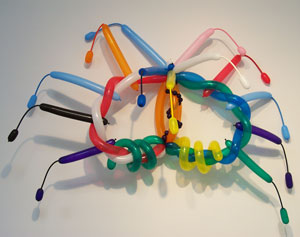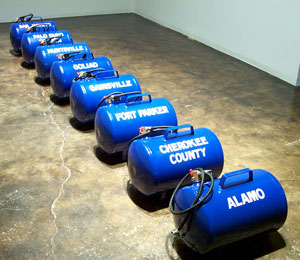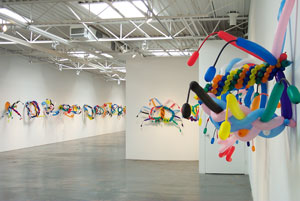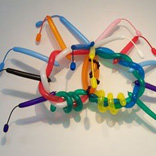Mel Ziegler has put balloons in the gallery. Warhol did it. Koons did it too.
Warhol did it in 1966 in Leo Castelli’s Gallery in New York. Calling them Silver Clouds, his were helium-filled, reflective, metallic, and meant to be touched by gallery goers. They created an atmosphere at once light-hearted and surrendering, whimsical yet of abandonment. Warhol’s goal was to announce the death of painting by setting free these interactive nimbi, sending them afloat out the window of the gallery to destinations free and unknown. Made some twenty years after Warhol, Koons’ balloons are also playful and witty, but static and monumental. Fabricated in stainless steel, his balloons are an ironic commentary on traditional sculpture, their kitschy form appearing both inside galleries, as with the carnival-scaled Rabbit (1986), and out, as with the classically-scaled Balloon Flower (Magenta) (1995-2000) that currently sits as if floating on the surface of the pond at Howard Rachofsky’s house in Dallas. Ultimately, Koons’ balloons are more bubble-like than anything else, references that in hindsight so clearly point to the bloated, precarious form of our American-born tulip manias of the last two decades – the boom, bust and schizophrenia of American bubble economics.
Setting Ziegler’s balloons apart from Warhol and Koons’ is the air inside of them. The thirty or so colorful balloons at Dunn and Brown are filled with air that came from a litany of known and not-so-well known historic sites in Texas – Palo-Duro Canyon, Gainesville, Cherokee County, Fort Parker, San Jacinto, Goliad, the Alamo, and the Texas State Penitentiary at Huntsville – locales that are at once bastard and legitimate in their often-forgotten claims to carnage and ugly human strife. This makes Ziegler’s colorful balloons an heir to the work of Duchamp above all else, in particular his Paris Air (1919), a glass vile that Duchamp had a pharmacist empty of all medicinal contents and then torch shut, leaving it resealed with the invaluable afflatus of Parisian air.
Ziegler’s balloons lay claim to the Duchampian legacy in another, perhaps more profound way. Beyond symbolically encapsulating air, Ziegler’s work also redefines certain terms that are fundamental to our thinking about art, just as Duchamp’s did some eighty years ago. The Belgian art historian Thierry de Duve famously described Duchamp’s penchant for re-framing such grounds as “pictorial nominalism,” or picture naming.[1] Duchamp used the readymade – his Fountain (1917) among others – as a metaphor to draw attention to the structures through which art is shot, those enabling skeletons that give form and shape to art. Duchamp’s readymades take on a certain linguistic candor, de Duve argues, revealing art’s construction by announcing “This is art.”[2] In similar fashion, Ziegler seeks to bring consciousness to the very structures by which we experience art. Where he redirects the nominalist impulse of conceptualism is with his fascination with history and historical contents. Instead of calling upon the viewer to singly question those structures that allow art to be, an act now rote to most all conceptual pieces, Ziegler asks the viewer to question history and historical understanding. History is the theme of Ziegler’s work. It is also the style – in so much as we understand his work to proffer a radically rethought and renewed understanding of the term “style” itself.

Mel Ziegler... Hold Your Breath Balloon 1, 2004... latex balloons filled with compressed air from 8 Texas sites... dimensions variable
“Style” in this instance makes itself legible not so much in terms of appearance – in the manner in which Ziegler, like Warhol and Koons before him, uses balloons to make form – but by way of intellectual contents. As such, the balloons are just one part of the greater conceptualist matrix Ziegler has devised. In perfect keeping with conceptualist antics, Ziegler did not fashion the balloons himself. Rather he orchestrated their construction, hiring balloon artist Bobby Cordell to twist, tweak and braid balloons into party hats. The air that fills them comes from a large blue reverse compressor mounted on a red granite base. The granite has been taken from the same quarry that provided stone to build the State Capitol in Austin. The compressor contains a mixture of air taken from several historic sites around Texas, the names of which have been painted in white on the front of the container. The sites range in bloodiness and ill-repute, from the more heroically mythical Alamo, where occurred the most famous battle of Texas independence, to the ignominiously forgettable Palo Duro Canyon, site of the Southern Indians’ final attempt to resist encroachment of the United States Cavalry. The bright, jolly balloons function as an ironic counterpoint to the bloody events of which they become the perverse embodiment. Casting a sense of levity, the balloons waft as viewers pass by, casting pretty penumbra in forced-perspective beneath. Just like the events of which they are a trace, they are temporary: the balloons deflate and become flaccid, not unlike our memories of past events.
Corresponding to the large blue compressor in the main gallery, there are eight small, individual air tanks of the same hue located in the smaller adjacent gallery. This piece is titled Compression and, like Hold Your Breath, contains air from eight historical sites around Texas. Here, however, the air remains discrete and unmixed. Also in this smaller gallery one finds projected on the wall Ziegler’s website, the projection of which he has titled Seeking Sponsorship. Ziegler there offers “for sale” eleven conceptual projects: American Landscapes, Enchanted Air, Monument Glow, Left/Right, Machine Shop, Game, Up/Down, Glow, Measure, In Tow and Job Market.
While the theme of history is less palpable in these yet-to-be-realized projects, we might look to other similar projects, such as Stuffed and Come and Go, already realized by Ziegler in various cities around the world, for proof of his stylistics of history. Stuffed (2003), Ziegler’s installation of straw-filled vitrines in department stores and boutiques around central Vienna, paid tongue-in-cheek homage to the bourgeoisie of the nineteenth century, especially their manner of giving wedding-cake form and culture to the city. In Come and Go (1998) Ziegler placed five historic reproduction street lamps on a 40-foot flatbed in the city of Cleveland, Ohio. The lights would go on at night, ironically scrutinizing the theme of “olden days” that is often used as part of urban renewal and gentrification strategies.
These older works, like Hold Your Breath, use history not as mere subtext but as intellectual substance and activity. In turn, Ziegler breathes life into a new sense of style. Style in the hands of Ziegler is not solely circumscribed by appearance, by trend registering upon surface, but, more poignantly, by provocation and immediacy. Ziegler’s work, in particular Hold Your Breath, forces us to look once again at Nietzsche’s idea of “forgetting” as necessary antidote to bad historical thinking – history run amok by narcissism and the will to power. Ziegler thus brings us into the realm of history as forgetting, revealing in his work that Nietzschean forgetting may very well be the most potent form yet of historical activism.

Mel Ziegler ... Compression, 2004... 8 individual air tanks filled with air collected from historical sites around Texas...
For a full understanding of Ziegler’s stylistics of history, we turn briefly to Nietzsche’s youthful text On the Advantage and Disadvantage of History for Life (1874). There, Nietzsche implored his readers to think of history as something alive, a constant event that flowed into the present. He exhorted, “we require history for life and action, not for the smug avoiding of life and action, or even to whitewash a selfish life and cowardly, bad acts.”[3] Living history stood in marked contrast to the stillborn history writing of Nietzsche’s lifetime. Nietzsche responded to the claims of politically motivated productions of history – the formation of the European Nation-State based on old tribalisms combined with the modern pursuit of empire and an incipient global capital. Within the arena of art and architecture, we might look to the rampant quoting of styles on the exterior of buildings, what is otherwise known in architecture as nineteenth-century historicism, for another example of weak historical production. In opposition to such anemic historicisms, Nietzsche called for humans to live like animals: to live each moment according its immediacy, forgetting it when past rather than fetishizing it arbitrarily – or in accordance with national and nationalistic needs.[4]
In calling upon us to forget, thus, Nietzsche does not demand that we literally forget specific events, but rather – as with Duchamp, the readymade and “art” – that we scrutinize the very foundations of history itself. Acts of Nietzschean forgetting thus point us toward a fundamental questioning of what constitutes historical fact and what does not, a looking toward the events remembered and those that have been truly forgotten – those that lie both within and without the purview of history and history’s fabrication. Ziegler’s stylistics of history function according to this notion of history, or what we might also call a self-critical history that is equally a Nietzschean forgetting. Looking to another work by de Duve, namely his Kant after Duchamp, we find ourselves with a new take on “style” that is based on reading Nietzsche after Ziegler. While maintaining its role has helpful category, style becomes instigator of manifold questioning – a provocateur and force for querying what is meant by “history,” looking at histories both past and present as repositories of limiting and closed traditions, rethinking history anew and welcoming those yet to come.
1. Duve, Thierry de, Pictorial Nominalism: On Marcel Duchamp’s Passage from Painting to the Readymade, trans. Dana Polan (Minneapolis: University of Minnesota Press, 1991). See also Thierry de Duve, “Echoes of the Readymade: Critique of Pure Modernism,” October, Vol. 70 (Autumn 1994) 68-70.
Images courtesy the artist and Dunn and Brown Contemporary.
Charissa N. Terranova is an Adjunct Professor in Art History at Southern Methodist University.




